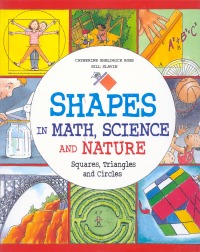| ________________
CM . . .
. Volume XXI Number 4 . . . . September 26, 2014
excerpts:
Catherine Sheldrick Ross has written a book about squares, triangles and circles and their three dimensional counterparts; cubes, tetrahedrons, and spheres, that is remarkable. In fact, before reading Shapes in Math, Science and Nature, it might be difficult for parents, teachers, librarians and youth to believe it’s possible to fill 142 pages with intriguing information, thought-provoking activities and challenging puzzles focused on planar and three-dimensional shapes. Yet, this is exactly what Ross and illustrator Bill Slavin have achieved in Kids Can Press’ 2014 compilation of Circles published in 1992, Triangle published in 1994, and Squares published in 1996. If you recall these three books or have copies that are worn from use, you’ll be delighted to know that they are now available as a single work. Shapes in Math, Science and Nature begins with a table of contents that spans three pages. Each of these three pages is associated with one of the two-dimensional shapes. As such, it’s immediately obvious that the first third of the text is focused on squares, that the middle third is about triangles, and that final third before the answer key, formulas, glossary and index is concerned with circles. The table of contents also makes clear that the topics addressed in each section go far beyond definitions, terminology, and how to construct or draw a particular shape. The “Triangles” section, as one example, has the following sub-headings: “amazing triangles”, “special triangles”, “building with triangles”, the “triangular prism”, the “tetrahedron”, and “pyramids”. Within the 12 pages associated with “amazing triangles”, Ross includes nine activities, one game, two puzzles, definitions of the parts of a triangle, and information about triangular numbers, the Pascal triangle, the Bermuda triangle, and illusionary triangles that includes 20th-century mathematician Roger Penrose’s optical illusion of a triangle that appears to have three 90° angles. The activities range from determining if there is a polygon that keeps its shape better than an equilateral triangle to discovering all of the hidden triangles in a square sheet of paper that has ben folded in half (top to bottom), folded in half again (right side to left side) and folded a third time (diagonally). Rather than tell readers about the similarities and differences between acute, right, and obtuse angles and the relationship of these angles to equilateral, isosceles, and scalene triangles, Ross invites them, through guided activities, to construct triangles and discover these similarities and differences. Only then does she provide the names. When learning that the three angles of a triangle, whatever the triangle’s shape, add up to 180°, Ross encourages readers to construct a triangle, to colour each corner of a triangle a different colour, to rip off the three coloured corners, and to fit the corners together around a single point. She then asks, “Do you think it was just lucky that you ended up with a straight line? Try it again with a different shaped triangle.” It is this approach, the promotion of active learning that requires readers to think and make sense of what Ross is inviting them to do and to know and the potential to have “ah-ha” moments, that makes Shapes in Math, Science and Nature remarkable. What draws one in, however, are the numerous, perfectly placed, and delightfully rendered illustrations of Bill Slavin. Slavin’s colourful drawings are perfect illustrations of Ross’ ideas and directions. Kudos to the original editor, Laurie Wark, and to the original designers, Michael Solomon and Esperança Melo, for decisions that resulted in such richness for readers young and old. Highly Recommended. Barbara McMillan is a teacher educator and a professor of science education in the Faculty of Education, the University of Manitoba.
To comment on this title or this review, send mail to cm@umanitoba.ca.
Copyright © the Manitoba Library Association. Reproduction for personal use is permitted only if this copyright notice is maintained. Any
other reproduction is prohibited without permission.
CM Home | Next Review | Table of Contents for This Issue - September 26, 2014 | Back Issues | Search | CM Archive | Profiles Archive |
